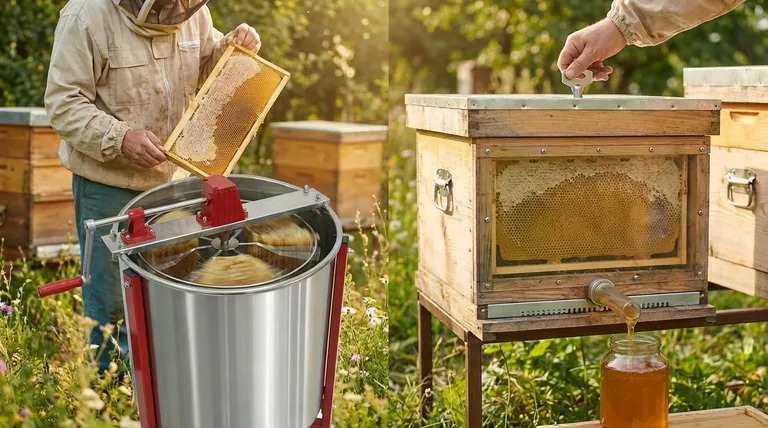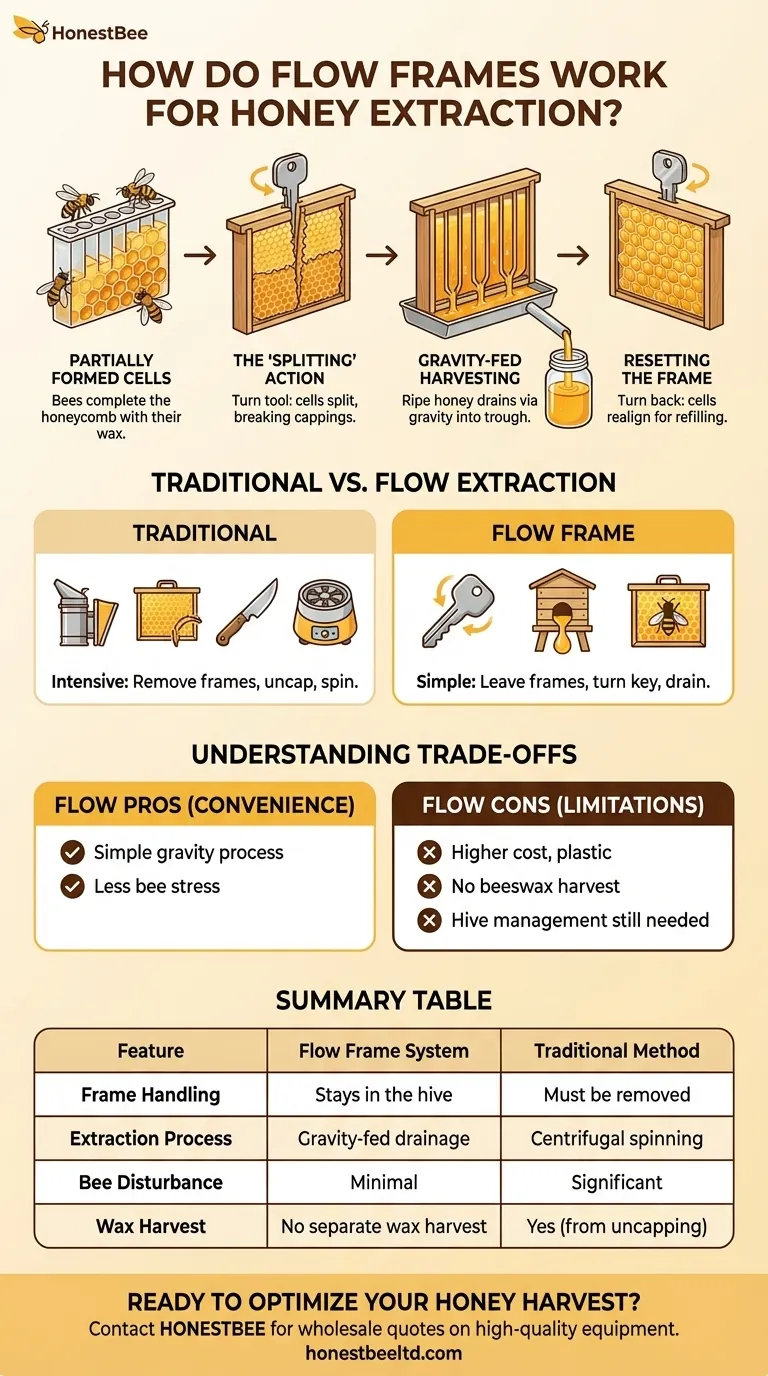At its core, a Flow Frame is a partially-formed plastic honeycomb that allows for honey extraction directly from the hive without removing the frame. By turning a dedicated tool, the cells within the frame split vertically, creating channels that allow ripe honey to flow downwards via gravity into a collection trough and out of the hive, leaving the bees and the core wax structure largely undisturbed.
Flow Frames revolutionize honey extraction by transforming it into a simple, gravity-fed process, but they do not eliminate the fundamental responsibilities of beekeeping. Understanding their mechanics reveals a trade-off between unprecedented convenience and the limitations of a specialized, plastic-based system.

The Mechanics of a Flow Frame
To grasp how Flow Frames work, it’s best to break the process down into its key stages, from how the bees interact with the frame to the moment you harvest honey.
Partially Formed Honeycomb Cells
Flow Frames are not a complete replacement for the bees' work. They consist of a series of pre-formed, food-grade plastic cells that are incomplete. The bees must first complete the honeycomb by coating the plastic framework in their own beeswax before they begin filling the cells with nectar.
The 'Splitting' Action
The defining feature is the mechanism for extraction. Once the bees have filled the cells and capped the honey with wax, the beekeeper inserts a special tool or key into the top of the frame and turns it. This action shifts the two halves of each honeycomb cell vertically, breaking the wax cappings and creating continuous channels through the frame.
Gravity-Fed Harvesting
With these channels open, the ripe honey, which is now unsealed, simply drains downwards. It flows through the frame, into a collection trough at the bottom, and out through a tube into your jar. The process is gentle and relies entirely on gravity, eliminating the need for a centrifuge.
Resetting the Frame
After the honey has been drained, the beekeeper turns the key back to its original position. This realigns the cells. The bees then begin the process of repairing the wax cappings and can start refilling the now-empty cells with new nectar.
How This Differs from Traditional Extraction
The innovation of Flow Frames is best understood by contrasting it with the highly involved process of traditional honey harvesting.
Eliminating Frame Removal
Traditionally, a beekeeper must open the hive, often using smoke to pacify the bees, and physically remove the heavy frames of honey. This is a significant disturbance to the colony. Flow Frames allow the honey super (the box containing the frames) to remain in place on the hive during extraction.
Bypassing the "Honey House"
Traditional extraction requires a dedicated, bee-proof space and specialized equipment. The process involves scraping the wax cappings off each frame (uncapping), placing the frames in a centrifugal extractor to spin the honey out, and then filtering the resulting honey. Flow Frames bypass all of these labor-intensive steps.
Reducing Bee Disturbance
Because the hive remains sealed and the bees are not brushed or blown off the frames, the process is significantly less stressful for the colony. The bees inside the hive are largely unaware that the honey is being drained from the other side of the comb.
Understanding the Trade-offs
While the convenience is undeniable, choosing Flow Frames involves considering several important trade-offs against traditional methods.
Cost and Materials
Flow Hives and frames are a significant investment compared to standard wooden Langstroth equipment. Furthermore, the frames are made of plastic, which some beekeepers prefer to avoid in favor of all-natural wood and wax.
No Beeswax Harvest
With traditional uncapping or the "crush and strain" method used by some small-scale beekeepers, you harvest a significant amount of beeswax as a valuable byproduct. Because Flow Frames leave the wax structure intact within the hive, you do not get a separate wax harvest.
Hive Management Is Still Required
Flow Frames simplify extraction, not beekeeping. You are still fully responsible for all aspects of hive health, including pest and disease management, swarm prevention, and ensuring the colony has enough resources. Critically, you must still inspect the frames to ensure the honey is fully capped before harvesting to ensure it has the correct moisture content and is ripe.
Making the Right Choice for Your Goal
Selecting a honey harvesting method depends entirely on your personal beekeeping philosophy and objectives.
- If your primary focus is convenience and minimal bee disturbance: Flow Frames are an outstanding choice, making the harvest process uniquely simple and gentle.
- If your primary focus is minimizing cost or using all-natural materials: A traditional Langstroth hive with wooden frames and wax foundation is the superior path.
- If your primary focus is harvesting both honey and beeswax: Traditional extraction or the crush and strain method is necessary, as Flow Frames are designed to leave the wax comb intact.
Ultimately, understanding the core mechanics and trade-offs empowers you to choose the harvesting method that best aligns with your goals as a beekeeper.
Summary Table:
| Feature | Flow Frame System | Traditional Method |
|---|---|---|
| Frame Handling | Stays in the hive | Must be removed from the hive |
| Extraction Process | Gravity-fed drainage | Centrifugal spinning (extractor) |
| Bee Disturbance | Minimal | Significant (brushing/smoking) |
| Wax Harvest | No separate wax harvest | Yes (from uncapping) |
| Key Equipment | Flow Frame and key | Uncapping knife, extractor, filters |
Ready to optimize your honey harvest?
At HONESTBEE, we supply commercial apiaries and beekeeping equipment distributors with the high-quality tools they need to succeed. Whether you're considering the innovative Flow Frame system or traditional Langstroth equipment, our wholesale-focused operations ensure you get reliable, durable supplies.
Let us help you choose the right harvesting method for your operation's goals. Contact our expert team today to discuss your needs and request a wholesale quote!
Visual Guide

Related Products
- HONESTBEE 6 Frame Three Use Electric Honey Extractor for Beekeeping
- 6 Frame Manual Stainless Steel Honey Extractor Beekeeping Equipment
- Vertical Motor Kits for 2 3 4 Frame Electric Honey Extractors
- Plastic Hand Crank 2 Frame Honey Extractor Low Price
- Stainless Steel Manual Honey Press with Guard for Pressing Honey and Wax
People Also Ask
- What is the basic principle of the honey extractor? Harness Centrifugal Force for Efficient Harvesting
- What are the two main types of honey extractors? Choose Between Tangential and Radial for Your Apiary
- What type of honey extractor is best? Maximize Your Harvest Efficiency with the Right Choice
- What is the process of using an extractor to harvest honey? Master Efficient, Comb-Preserving Harvests
- What is the best type of honey extractor? Find the Perfect Match for Your Beekeeping Scale



















